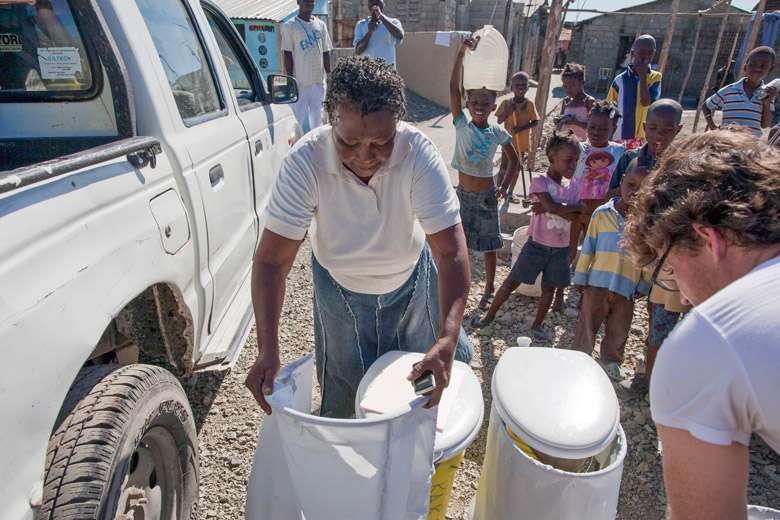Researchers create a promising solution for urban toilets

They call them frogmen. Their job is to climb into 8-foot-deep pit latrines, empty them with a bucket, then cart away mountains of human waste.
In Haiti's urban slums, where frogmen operate, people must choose among crowded public toilets that close at night, open defecation or expensive private pit latrines. Narrow, unplanned street layouts make access by suction trucks impossible, and frequent flooding sends raw sewage into homes.
Of the 2.5 billion people worldwide who lack access to adequate sanitation, about 750 million live in cities.
A Stanford-led study found that portable, affordable dry household toilets, in combination with a waste removal service, reduced the amount of unmanaged feces in a Haitian slum by a factor of 3.5 and among service users nearly eliminated open defecation and "flying toilets" – a common practice in which people throw into waterways plastic bags full of feces.
So-called container-based sanitation (CBS) could be a short- or long-term solution in the urban slums of Haiti and elsewhere, where conventional sewerage is not feasible due to the need for large up-front capital investments and reliable water and energy supplies, among other factors.
"Lots of research has shown that the biggest challenges in urban sanitation include effectively capturing, isolating and removing waste from dense areas, and doing so with a service that people are willing to pay for," said study lead author Sebastien Tilmans, who obtained his PhD in civil and environmental engineering from Stanford in January. "Our findings show that CBS can achieve both of those goals in areas where traditional approaches have failed." (See slideshow here.)
Tilmans and civil and environmental engineering graduate student Kory Russel co-founded an initiative called re.source. Under the guidance of Jenna Davis, an associate professor of civil and environmental engineering and the Higgins-Magid Senior Fellow at the Stanford Woods Institute for the Environment, the team is developing a container-based system and an entrepreneurial service model for the developing world. The study is based on a three-month trial during which households in a slum of Cap-Haïtien, Haiti, received a re.source toilet and a waste removal service for free.
The findings show that the service collected more feces by weight than was initially estimated, indicating that some people who received the service provided access to neighbors and friends.
"CBS is more convenient for users," said Russel. "That means more use, less feces in the general environment and, ultimately, more investment in sanitation."
By isolating the waste collected from users and service providers, CBS offers a hygienic alternative to pit latrines. Its 24/7 in-house availability is a major advantage over public facilities that can be closed or unsafe at night. Because it is movable and not dependent on a pipe system, CBS is advantageous for renters or transient residents, and good for municipalities that want to avoid legitimizing illegal or informal land development with permanent infrastructure. These issues will only intensify as cities in low- and middle-income countries swell by an additional 2.4 billion people over the next 35 years.
Despite its advantages, CBS faces hurdles. The total operations and management cost for the service during the pilot program was considerably more than the cost of public toilets or conventional sewerage. The study's authors point out, however, that the price of CBS will come down dramatically with available cost-saving measures and economics of scale.
"There are more than 750 million people without access to basic sanitation in cities, and sewers will be a long time coming," Tilmans said. "I think CBS can play a huge role in bridging that gap. The next step is to expand a service to thousands of households to verify how CBS performs at scale."
Tilmans and his co-authors suggest that further research is needed to analyze the costs of CBS waste treatment and management at various scales, and to examine the potential for revenue generation through waste processing and recovery of resources such as phosphorus and nitrogen. Among other recommendations, they call for expanded study of:
- Appropriate planning and regulatory frameworks for waste collection and management
- Urine-processing facilities close to CBS users
- Alternative container collection systems to achieve greater operational efficiency
- CBS hardware that can facilitate anal washing, so CBS can be implemented in markets where washing is the cultural norm
Russel and Tilmans, both fellows with Woods' Rising Environmental Leaders Program, will address some of these issues with related findings from their pilot study in a paper to be published this fall.
More information: Study paper: Container-based sanitation: assessing costs and effectiveness of excreta management in Cap Haitien, Haiti, eau.sagepub.com/content/27/1/8 … XCIkf&keytype=finite
Provided by Stanford University

















